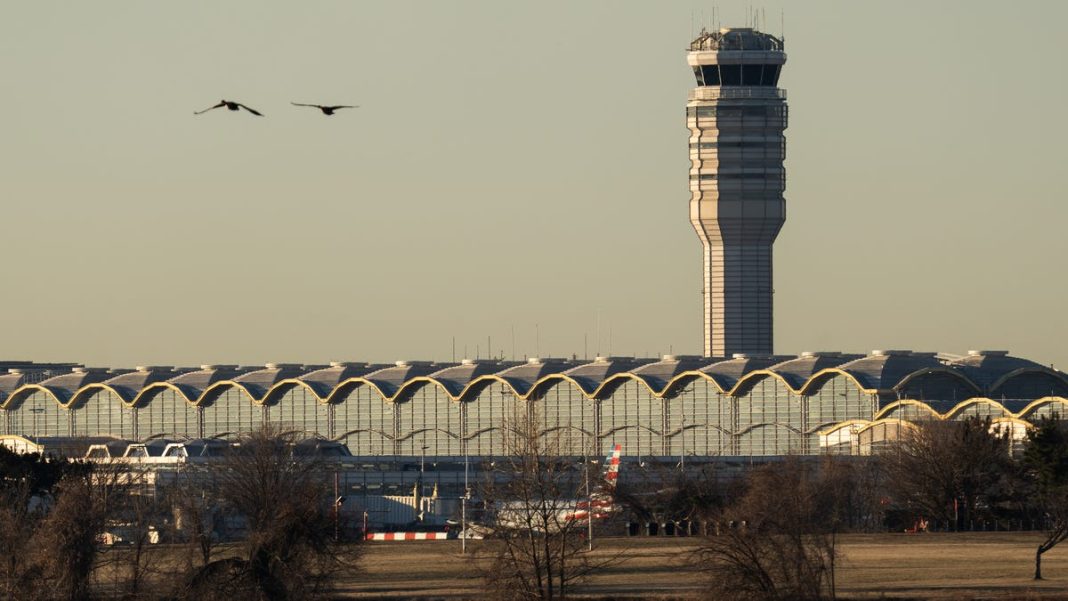A shorter commute: Lawmakers and lobbyists debate new flights at Reagan airport
Over the past two years, there has been heated lobbying regarding the possibility of adding more flights at Ronald Reagan Washington National Airport, notably the site of a tragic mid-air collision last Wednesday.
The number of flights at Reagan National is limited due to its busy nature. However, lawmakers are pushing for more direct flights to their home states, benefiting both themselves and their constituents, since Reagan is closer to downtown compared to Dulles International Airport, which is also under the management of the Metropolitan Washington Airport Authority. Although five new flights were approved last year, they have not yet started.
Last year, both Reagan and Dulles served approximately the same number of passengers, about 26 million. However, operators against adding flights at Reagan argue that the airport, constrained by the Potomac River, is only equipped to handle around 15 million passengers each year.
Amid this situation, lawmakers frequently vie for direct flights to their states. During 2023 and 2024, proposed bills aimed to introduce 28 new flights at Reagan across seven airline companies. Those against the expansion warned that adding more flights would worsen congestion and threaten safety.
This debate made headlines in the Wichita Eagle of Kansas, which celebrated a new direct flight to Reagan, designated by the airport code DCA, which started in January 2023. Former United Airlines pilot and Kansas state Senator Michael Murphy advocated for lifting the restrictions and increasing the number of flights.
“As a pilot, safety is the top priority. While DCA is indeed a busy airport, if I believed adding more flights was unsafe, I wouldn’t support it,” Murphy stated, criticizing United, his former employer, for opposing the plan at that time.
United, which has a major presence at Dulles, around 25 miles away, opposed adding flights at Reagan due to fears that extra flights could lead to reductions at other airports.
Conversely, Delta Air Lines pushed for more flights at Reagan to compete with Dulles. Delta even established a nonprofit called the Capital Access Alliance, which orchestrated a lobbying and social media campaign, funded by industries from Western states. This organization is now defunct, and Delta did not respond to requests for information.
Delta’s lobbying efforts cost approximately $5.2 million in 2023 and another $4.2 million in 2024, as reported by OpenSecrets. Meanwhile, United spent around $11.5 million during the same period. American Airlines also opposed the changes and invested about $8.1 million overall.
Although the legislation to introduce 28 flights didn’t pass, parts of the expansion were incorporated into the Federal Aviation Administration’s reauthorization bill last year. The initiatives received backing from notable legislators from Western states, including Sen. Ted Cruz of Texas, Sen. Maria Cantwell of Washington, and Rep. Burgess Owens of Utah.
Soon after, in May, President Joe Biden enacted the bipartisan reauthorization law, which included five new flights from Reagan National: Delta to Seattle-Tacoma, American to San Antonio, United to San Francisco, Southwest Airlines to Las Vegas, and Alaska Airlines to San Diego. The lobby group backed by Delta celebrated this milestone.
A coalition of Democrats, including Sens. Mark Warner and Tim Kaine from Virginia and Sens. Ben Cardin and Chris Van Hollen from neighboring Maryland, opposed the expansion last year, cautioned that it would lead to “increased delays and jeopardize safety at DCA.”
They noted in an op-ed that DCA already had the third-highest cancellation rate among airports and pointed out that delays averaged 67 minutes from 2020 to 2022.
“The safety of the flying public must be our primary concern, especially after several high-profile incidents and near-misses that underscore the need for a safe and well-maintained National Airspace System,” they stressed.
Another aspect of the discussion surrounding Reagan National involves an outdated rule regarding flight distance. The “perimeter rule” from the 1960s restricts flights to destinations not more than 1,250 miles away from the airport.
This regulation allows easy access to cities like Miami, New Orleans, Chicago, and Minneapolis, while passengers heading to places such as San Antonio, Albuquerque, and Reno must connect through another airport. Direct flights to destinations like Las Vegas, San Francisco, and Salt Lake City are also limited.
“Reagan National is the only airport in the United States restricted by Congress to flights no further than 1,250 miles,” Cruz pointed out during a Senate session last May. “This is absurd and unfair to millions of travelers who must pay higher fares because of this rule.”
The late Sen. John McCain was a prominent opponent of the perimeter rule throughout his Senate career. He spearheaded an effort to repeal it in 1999 that ultimately failed but was instrumental in creating an exemption allowing three daily nonstop flights between Washington and Phoenix.
In a notable move, McCain refused to take the new nonstop flight to avoid appearing as someone seeking to shorten his commute for personal gain.
This story has been updated with the latest passenger count for Ronald Reagan Washington National Airport.

